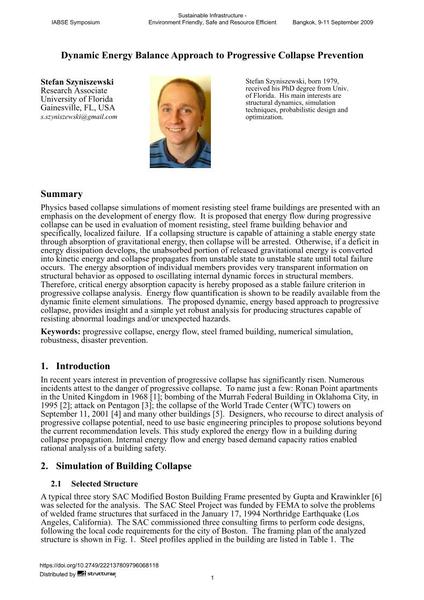Dynamic Energy Balance Approach to Progressive Collapse Prevention

|
|
|||||||||||
Bibliographic Details
| Author(s): |
Stefan Szyniszewski
|
||||
|---|---|---|---|---|---|
| Medium: | conference paper | ||||
| Language(s): | English | ||||
| Conference: | IABSE Symposium: Sustainable Infrastructure - Environment Friendly, Safe and Resource Efficient, Bangkok, Thailand, 9-11 September 2009 | ||||
| Published in: | IABSE Symposium Bangkok 2009 | ||||
|
|||||
| Page(s): | 52-61 | ||||
| Total no. of pages: | 8 | ||||
| Year: | 2009 | ||||
| DOI: | 10.2749/222137809796068118 | ||||
| Abstract: |
Physics based collapse simulations of moment resisting steel frame buildings are presented with an emphasis on the development of energy flow. It is proposed that energy flow during progressive collapse can be used in evaluation of moment resisting, steel frame building behavior and specifically, localized failure. If a collapsing structure is capable of attaining a stable energy state through absorption of gravitational energy, then collapse will be arrested. Otherwise, if a deficit in energy dissipation develops, the unabsorbed portion of released gravitational energy is converted into kinetic energy and collapse propagates from unstable state to unstable state until total failure occurs. The energy absorption of individual members provides very transparent information on structural behavior as opposed to oscillating internal dynamic forces in structural members. Therefore, critical energy absorption capacity is hereby proposed as a stable failure criterion in progressive collapse analysis. Energy flow quantification is shown to be readily available from the dynamic finite element simulations. The proposed dynamic, energy based approach to progressive collapse, provides insight and a simple yet robust analysis for producing structures capable of resisting abnormal loadings and/or unexpected hazards. |
||||
| Keywords: |
robustness progressive collapse numerical simulation energy flow steel framed building disaster prevention
|
||||
